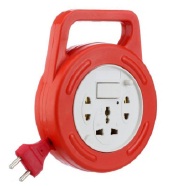July 18: SPOTLIGHT
Are you using your extension cord the proper way?
We have grown to become over-dependent on electrical appliances in daily life. An outcome of this is the increased use of extension cords or power strips at homes, offices and kitchens. Multiple appliances are plugged in to an extension cord because the number of appliances we use is much more than the wall sockets that we have. This is one major mistake that we make with our extension cords.
There are many outlets on an extension cord, but that doesn’t mean that we should be utilizing all of them. If an extension cord has six outlets and all of them are being used, that much electricity is going into the main outlet that the cord is into. This brings the risk of blowing the fuse if the circuit breaker trips. Not only that, but you also run the risk of starting a potential fire.
There is a common mistake when comparing extension cords and power strips to surge protectors. They are not same. If a surge protector gets overloaded, it will automatically cut off the power. While a power strip or extension cord, it won’t cut the power, which is why the circuit trips or the fuse blows.
It is not just the number of appliances that are connected to an extension cord that matter, but also the type of appliances. There are certain things, like a fan, lamp and radio that don’t draw much power. Even a computer or a television doesn’t draw a tremendous amount of power. But heating products, like a toaster, a hair dryer and room heater, draw a lot more current.
Remember
 Extension cords are meant for temporary use. They should not be used as a replacement for permanent wiring.
- If you find you are using too many power strips, it is time to call the electrician and get additional power outlets from the main supply.
- Always buy extension cord with proper certification.
Sources: www.providr.com, www.safebee.com, www.bijlibachao.com




